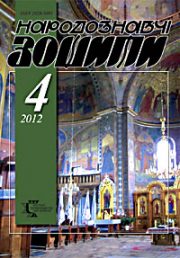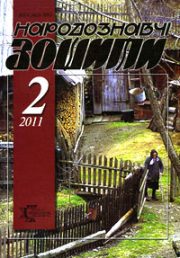The Ethnology Notebooks. 2023. № 3 (171), 719—730
UDK 7.071.1(477)(092)”1895/1991″О.Павленко
DOI https://doi.org/10.15407/nz2023.03.719
OKSANA PAVLENKO AND UKRAINE: LITTLE-KNOWN PAGES BIOGRAPHIES OF ARTISTS
SAVKO Julian
- Associate Professor of the Department of Academic Drawing,
- Lviv National Academy of Arts,
- Honored Artist of Ukraine,
- 38, Kubiyovych st., Lviv, 79011, Ukraine,
- Contacts: e-mail: savkojulian@gmail.com
Abstract. The article is dedicated to one of the little-known pages of the biography of a prominent Ukrainian artist, a classic of the artistic avant-garde, a student of M. Boichuk, Oksana Pavlenko (1895—1991). It is based on the materials of the author’s personal contacts with the artist in the period of the late 1960s — early 1970s, which were connected with the circumstances of the organization of her personal exhibition in the Lviv Art Gallery (1970).
The relevance of the article lies in the fact that, for the first time, a group of original epistolary documents — letters written by O. Pavlenko to the author of the publication during 1969—1972 — were introduced into scientific circulation. They provide an opportunity to scientifically reconstruct certain details of the creative biography of the artist. Taking into account the fact that during the period of restoration of the Ukrainian state, a number of researchers turned to the figure of Oksana Pavlenko, most of these publications consider her works or highlight the aspect of influences on her painting language of the concept of neo-Byzantineism developed by her direct professional mentor Mykhailo Boychuk.
Information about the artist’s connections with Ukraine during her forced stay outside the Motherland is less well known.
The object of the study is the scientifically reliable facts of the author’s contacts with O. Pavlenko in the chronology of 1969—1972, the subject is the circumstances, thanks to which the connection of the artist with Ukraine deepened.
The methodological basis of the research is biographical, historical-cultural and scientific-reconstructive methods, which allowed to consider at an interdisciplinary level the complex of factors that preceded and accompanied the organization of the artist’s personal exhibition in Lviv in February-March 1970.
Keywords: Oksana Pavlenko, school of Mykhailo Boychuk, Ukrainian modernism, neo-styles, neo-Byzantineism, Boychukism, «shot revival», painting, monumental art, graphics, epistolary heritage, cultural memory, correspondence.
Received 16.06.2023
REFERENCES
- Bilokin’, S. (1988). The Ukrainian artist Mykhailo Boychuk returns to us from under falsehood. Ukraine, 9, 11—12 [in Ukrainian].
- Bilokin’, S. (1988). Collectivism — the pathos of Mykhailo Boychuk’s work. Fine Art, 1, 22—25 [in Ukrainian].
- Ripko, O., & Prystalenko, N. (Eds.). (1991). Boychuk and Boychukists, Boychukism: Monumental art. Painting. Graphics. Book. Decorative and applied art. Photo. Documents: Catalog of the exhibition. Lviv: Editorial and publishing department of the region. press management [in Ukrainian].
- Cherevatenko, L. (1987). «Speak — my life — and hold back your tears…»: (memoirs of O. Pavlenko). Science and Culture. Ukraine: yearbook (Issue 21, pp. 360—384) [in Ukrainian].
- Cherevatenko, L. (1989, may). One and a half bells to Oksana Trokhymivna. Ukraine, 20, 11—14[in Ukrainian].
- Okhmakevych, N. (1988, august 4). «Images of Oksana Pavlenko’s Time»: (from person. ext. artist). Literary Ukraine, 31 [in Ukrainian].
- Klymenko, N. (2002). Memory of Oksana Pavlenko. Fine Art, 1, 22 [in Ukrainian].
- Kravchenko, Ya. (2010). Mykhailo Boychuk School. Thirty Seven Names. Kyiv: Book Workshop; Oranta [in Ukrainian].
- Kravchenko, Ya. (2003). Those who knew Mykhailo Boychuk: (from the letters of O. Pavlenko). Fine Art, 4, 20—22 [in Ukrainian].
- Kravchenko, Ya. (2015, march 5). The last of the «Boichukists» cohort. To the 120th anniversary of the birth of the artist Oksana Pavlenko. Day. Kyiv [in Ukrainian].
- Sokolyuk, L. (2002). Graphics by Oksana Pavlenko. Boychukist graphics (Pp. 173—191). Kharkiv; New York [in Ukrainian].
- Plyukhina, O. (2011). Traditions of Boychukism in the work of Oksana Pavlenko. Museum Almanac (Issue 2, pp. 49—52). Cherkasy [in Ukrainian].
- Zhmurko, T. Portrait: Oksana Pavlenko. About boychukism, feminism and construction of a new future. Retrieved from: https://supportyourart.com/stories/oksana-pavlenko/
- Shot revival. Retrieved from: https://uk.wikipedia.org/wiki/%D0%A0%D0%BE%D0%B7%D1%81%D1%82%D1%80%D1%96%D0%BB%D1%8F%D0%BD%D0%B5_%D0%B2%D1%96%D0%B4%D1%80%D0%BE%D0%B4%D0%B6%D0%B5%D0%BD%D0%BD%D1%8F
- (1970). Exhibition of works by Oksana Pavlenko: (Exhibition booklet). Lviv: Lviv State Art Gallery [in Ukrainian].






